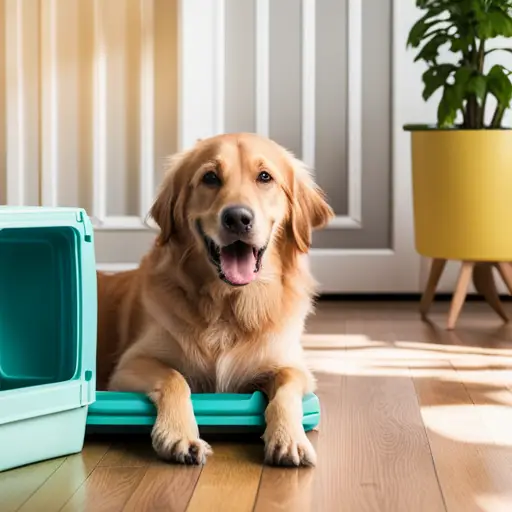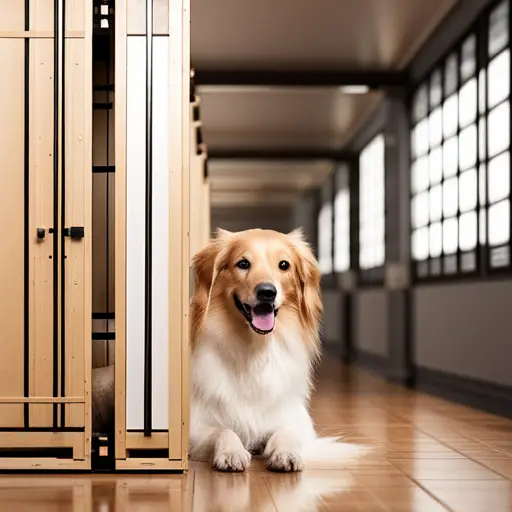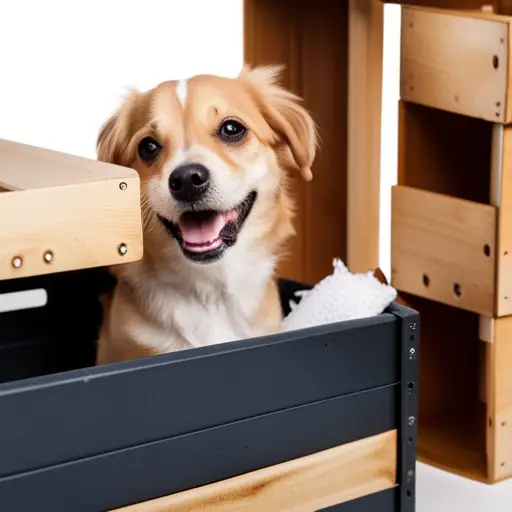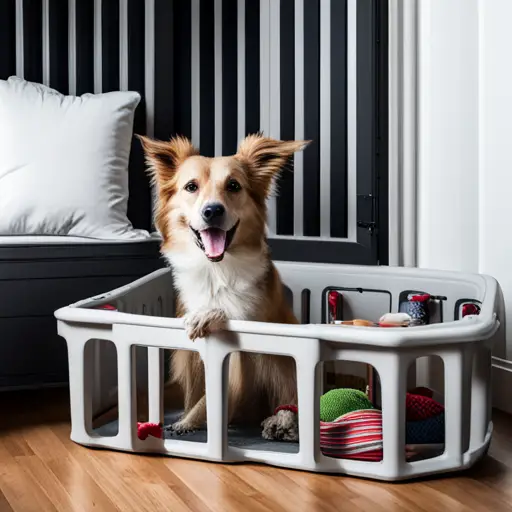Do you want to have a well-behaved and obedient dog? Crate training might just be the solution you’re looking for. Not only does it provide a safe and comfortable space for your furry friend, but it can also help with house training and prevent destructive behavior.
In this article, we’ll cover everything you need to know about crate training for dogs, from understanding its benefits to addressing common concerns.
Firstly, it’s important to understand that crate training is not about punishing your dog or keeping them locked up for hours on end. Rather, it’s a tool that can help your dog feel secure and comfortable, especially during times of stress or anxiety. It can also aid in potty training and prevent destructive behavior when you’re away from home.
By providing a designated space for your dog, you give them a sense of security and ownership, which can ultimately lead to a happier and more well-behaved pup. So, let’s dive into the world of crate training and discover how it can benefit both you and your furry friend.
Key Takeaways
– Crate training can provide a safe and comfortable space for dogs, help with house training and prevent destructive behavior, and lead to a happier and more well-behaved pup.
– Choosing the right crate size and material, introducing the crate with positive reinforcement, and monitoring behavior during crate training are all important for safety and comfort.
– Crate training should not be about punishment or confinement, and overusing the crate can lead to negative associations.
– Alternative training methods, such as playpens or gated areas and positive reinforcement training, can also be effective.
Understanding the Benefits of Crate Training

You’re probably wondering why crate training is so important for your furry friend, but let me tell you, it has numerous benefits that will make both you and your pup happier in the long run.
One of the main benefits of crate training is positive reinforcement. By rewarding your dog for good behavior and allowing them to have a safe and comfortable space to call their own, you’re creating a positive association with the crate and encouraging them to use it willingly.
Another benefit of crate training is the long term effects it can have on reducing anxiety in your pup. When used correctly, a crate can become a safe haven for your dog, a place where they feel secure and can go to escape from stressful situations.
By providing a crate that is appropriately sized for your dog, you can minimize any feelings of claustrophobia and ensure your pup is comfortable.
With all these benefits in mind, it’s important to choose the right crate for your dog.
Choosing the Right Crate

It’s important to find the perfect fit for your furry friend’s new home away from home, so it’s best to measure their dimensions before making a purchase, lest they end up feeling like they’re stuck in a clown car.
You want to make sure your dog has enough room to stand up, turn around, and lie down comfortably. The right crate size is important for their safety and well-being. Keep in mind that puppies will grow quickly, so it’s best to choose a crate that will accommodate their adult size.
When it comes to material options, there are a few things to consider. Plastic crates are easy to clean and can provide a sense of security for your dog, while wire crates offer more visibility and ventilation. Soft-sided crates are lightweight and portable, but may not be as durable as other options.
The important thing is to choose a crate that is safe and comfortable for your furry friend. Now that you have found the perfect crate, it’s time to introduce your dog to their new home.
Introducing Your Dog to the Crate

Once your furry friend has the perfect crate, they may need a little encouragement to feel comfortable spending time inside. One key to successfully introducing your dog to the crate is positive reinforcement.
Start by creating a comfortable space inside the crate with soft bedding and a few of your dog’s favorite toys. Gradually introduce your dog to the crate by leaving the door open and allowing them to explore the space on their own. You can also place treats or toys inside the crate to entice your dog to go inside.
When your dog begins to feel more comfortable inside the crate, start gradually closing the door while they are inside. Begin with just a few seconds and gradually increase the amount of time the door stays closed. Make sure to praise your dog and reward them with treats when they are calm and relaxed inside the crate.
Additionally, creating a feeding schedule that includes meals inside the crate can also help your dog associate the crate with positive experiences. With a little patience and positive reinforcement, your dog will soon be comfortable spending time in their crate.
This will lead to using the crate effectively as a tool for training and keeping your furry friend safe.
Using the Crate Effectively

Now that you’ve introduced your dog to the crate, it’s time to start using it effectively.
First, set a schedule for when you’ll use the crate – this can help your dog learn when it’s time to relax and when it’s time to play. However, be careful not to overuse the crate, as this can lead to negative associations with being confined.
Finally, make sure to monitor your dog’s behavior while they’re in the crate to ensure they’re comfortable and not experiencing any distress.
Setting a Schedule
To get your furry friend on track, you should start by creating a consistent schedule for their crate training. This means establishing specific times for when your dog will eat, play, and relieve themselves.
Crate training consistency is key to ensuring that your dog understands when it’s time to go into their crate and when it’s time to come out. Additionally, setting a consistent potty training routine can help prevent accidents in the crate.
To establish a schedule, consider the following nested bullet point list:
– Determine your dog’s feeding schedule and stick to it. This will help regulate their bowel movements and make potty training easier.
– Set aside specific times for play and exercise. This will help your dog burn off energy and reduce the risk of restlessness in the crate.
– Create a routine for potty breaks. This will help your dog understand when it’s time to go outside and when it’s time to come back in.
By setting a schedule, you can help your dog adjust to their crate and create a sense of routine in their daily life. However, it’s important to also avoid overusing the crate.
Avoiding Overuse
If you constantly confine your furry friend to their crate, they may become anxious and feel trapped, leading to destructive behavior and a decrease in overall happiness. Crate training is a useful tool for potty training and establishing boundaries, but it should not be overused. To avoid this, consider alternative training methods and gradually transition your dog out of the crate.
One alternative training method is to use a playpen or gated area instead of a crate. This allows your dog to have more space to move around and play while still being confined to a specific area. Another option is to use positive reinforcement training, where you reward your dog for good behavior instead of punishing them for bad behavior. By gradually transitioning your dog out of the crate and into these alternative methods, you can prevent anxiety and promote a happier and healthier relationship with your furry friend. In the next section, we will discuss how to monitor your dog’s behavior to ensure they are adjusting well to the gradual transition.
Monitoring Your Dog’s Behavior
Keep an eye on how your furry friend reacts to changes in their routine, such as being given more freedom to move around and play. This ensures they are adjusting well and remaining happy and content. Positive reinforcement is key when crate training, but it’s also important to use supervision techniques to ensure your dog is safe and secure.
Always keep an eye on your dog’s behavior and make adjustments as needed to ensure their comfort and safety. If your dog seems stressed or anxious during crate training, try to identify the cause and address it appropriately. This may involve adjusting the size of the crate or providing additional toys or treats to keep your dog occupied.
Addressing common concerns during crate training can help ensure your dog remains happy and content, while also providing you with peace of mind knowing your furry friend is comfortable and secure.
Addressing Common Concerns

One of the most common worries about crate training dogs is whether or not it’s cruel. However, crate training is actually a safe and humane way to train your dog, as long as it’s done correctly.
One of the biggest crate training myths is that it’s equivalent to locking your dog up in a small prison cell. In reality, crates are meant to be a comfortable and secure space for your dog to rest and feel safe in.
If you’re still unsure about crate training, there are crate training alternatives that you can consider. For example, you can use baby gates or exercise pens to confine your dog to a designated area instead of a crate.
However, keep in mind that crate training has many benefits, such as preventing destructive behavior and helping with potty training. Ultimately, the decision to crate train or not is up to you and what you believe is best for your dog.
Conclusion
So there you have it! Crate training is a fantastic way to help your dog feel safe and secure, while also giving you some peace of mind when you’re not able to keep an eye on them.
By choosing the right crate, introducing your dog to it gradually, and using it consistently and effectively, you can create a positive and happy environment for your furry friend.
Remember, patience and consistency are key when it comes to crate training. Don’t be discouraged if your dog doesn’t take to the crate right away – with a little time and effort, you’ll soon have a well-trained and happy pup.
As the saying goes, “Rome wasn’t built in a day”- but with crate training, you’re well on your way to creating a loving and harmonious home for you and your furry companion.
